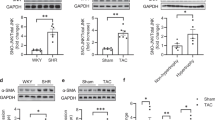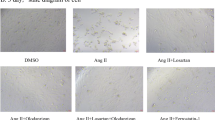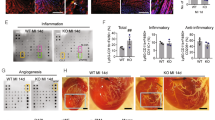Abstract
Aldosterone infusion with high salt treatment induces cardiac fibrosis in rats. Aldosterone enhanced angiotensin II (Ang II) has been shown to induce proliferation and increase the expression of Ang II receptor mRNA and Ang II binding in vitro. To investigate the role of Ang II type 1a receptor (AT1aR) in aldosterone-and-salt (Ald-NaCl)−induced cardiac fibrosis, we subcutaneously infused aldosterone (0.15 μg/h) and 1% NaCl (Ald-NaCl) into AT1aR knockout mice (AT1aR-KO) or wild type mice (Wt). To examine the role of NaCl on cardiac fibrosis, we gave some of the aldosterone-treated AT1aR-KO tap water (Ald-H2O). Ald-NaCl treatment increased systolic blood pressure and induced cardiac hypertrophy in both strains, whereas there were no such changes in the mice without aldosterone. Severe cardiac fibrosis was seen in Ald-NaCl–treated AT1aR-KO and not in Ald-NaCl–treated Wt. In contrast, Ald-NaCl–treated Wt with co-administration of an active metabolite of olmesartan, the AT1aR antagonist (10 mg/kg/day) did not show cardiac fibrosis. Na+/H+ exchanger, and Na+-K+ ATPase α2 subunit mRNA were decreased in AT1aR-KO. Na+/Ca2+ exchanger mRNA was lower in AT1aR-KO than Wt and was decreased by Ald-NaCl in both strains. Phosphorylation of epidermal growth factor receptor and extracellular signal–regulated kinase was increased by Ald-NaCl treatment in AT1aR-KO. Connective tissue growth factor (CTGF) and osteopontin mRNA were increased and accumulation of CTGF proteins was seen in the hearts of Ald-NaCl–treated AT1aR-KO. Ald-H2O–treated AT1aR-KO did not show any cardiac fibrosis. These results suggest that Ald-NaCl–induced cardiac fibrosis required both aldosterone and salt. Because cardiac fibrosis was exaggerated in Ald-NaCl–treated AT1aR-KO but was not seen in Wt treated with Ald-NaCl and olmesartan, AT1aR may not play a primary role in progression of cardiac fibrosis by Ald-NaCl, and gene disruption of AT1aR may have some implications in this model.
Similar content being viewed by others
Article PDF
References
Pearce P, Funder JW : High affinity aldosterone binding sites (type I receptors) in rat heart. Clin Exp Pharmacol Physiol 1987; 14: 859–866.
Lombès M, Oblin ME, Gasc JM, Baulieu EE, Farman N, Bonvalet JP : Immunohistochemical and biochemical evidence for a cardiovascular mineralocorticoid receptor. Circ Res 1992; 71: 503–510.
Takeda Y, Miyamori I, Inaba S, et al: Vascular aldosterone in genetically hypertensive rats. Hypertension 1997; 29: 45–48.
Brilla CG, Weber KT : Mineralocorticoid excess, dietary sodium, and myocardial fibrosis. J Lab Clin Med 1992; 120: 893–901.
Robert V, Silvestre JS, Charlemagne D, et al: Biological determinants of aldosterone-induced cardiac fibrosis in rats. Hypertension 1995; 26: 971–978.
Rocha R, Rudolph AE, Frierdich GE, et al: Aldosterone induces a vascular inflammatory phenotype in the rat heart. Am J Physiol Heart Circ Physiol 2002; 283: H1802–H1810.
Swedberg K, Eneroth P, Kjekshus J, Wilhelmsen L, CONSENSUS Trial Study Group: Hormones regulating cardiovascular function in patients with severe congestive heart failure and their relation to mortality. Circulation 1990; 82: 1730–1736.
Pitt B, Zannad F, Remme WJ, et al, Randomized Aldactone Evaluation Study Investigators : The effect of spironolactone on morbidity and mortality in patients with severe heart failure. N Engl J Med 1999; 341: 709–717.
Pitt B, Remme W, Zannad F, et al: Eplerenone, a selective aldosterone blocker, in patients with left ventricular dysfunction after myocardial infarction. N Engl J Med 2003; 348: 1309–1321.
Robert V, Heymes C, Silvestre JS, Sabri A, Swynghedauw B, Delcayre C : Angiotensin AT1 receptor subtype as a cardiac target of aldosterone: role in aldosterone-salt–induced fibrosis. Hypertension 1999; 33: 981–986.
Schiffrin EL, Franks DJ, Gutkowska J : Effect of aldosterone on vascular angiotensin II receptors in the rat. Can J Physiol Pharmacol 1985; 63: 1522–1527.
Xiao F, Puddefoot JR, Barker S, Vinson GP : Mechanism for aldosterone potentiation of angiotensin II–stimulated rat arterial smooth muscle cell proliferation. Hypertension 2004; 44: 340–345.
Mihailidou AS, Mardini M, Funder JW, Raison M : Mineralocorticoid and angiotensin receptor antagonism during hyperaldosteronemia. Hypertension 2002; 40: 124–129.
Kagiyama S, Eguchi S, Frank GD, Inagami T, Zhang YC, Phillips MI : Angiotensin II–induced cardiac hypertrophy and hypertension are attenuated by epidermal growth factor receptor antisense. Circulation 2002; 106: 909–912.
Kagiyama S, Qian K, Kagiyama T, Phillips MI : Antisense to epidermal growth factor receptor prevents the development of left ventricular hypertrophy. Hypertension 2003; 41: 824–829.
Nakano S, Kobayashi N, Yoshida K, Ohno T, Matsuoka H : Cardioprotective mechanisms of spironolactone associated with the angiotensin-converting enzyme/epidermal growth factor receptor/extracellular signal–regulated kinases, NAD(P)H oxidase/lectin-like oxidized low-density lipoprotein receptor-1, and Rho-kinase pathways in aldosterone/salt-induced hypertensive rats. Hypertens Res 2005; 28: 925–936.
Fan YY, Baba R, Nagai Y, et al: Augmentation of intrarenal angiotensin II levels in uninephrectomized aldosterone/salt-treated hypertensive rats; renoprotective effects of an ultrahigh dose of olmesartan. Hypertens Res 2006; 29: 169–178.
Sugiyama T, Yoshimoto T, Hirono Y, et al: Aldosterone increases osteopontin gene expression in rat endothelial cells. Biochem Biophys Res Commun 2005; 336: 163–167.
Sam F, Xie Z, Ooi H, et al: Mice lacking osteopontin exhibit increased left ventricular dilation and reduced fibrosis after aldosterone infusion. Am J Hypertens 2004; 17: 188–193.
Oliverio MI, Best CF, Smithies O, Coffman TM : Regulation of sodium balance and blood pressure by the AT1A receptor for angiotensin II. Hypertension 2000; 35: 550–554.
Jaffe IZ, Mendelsohn ME : Angiotensin II and aldosterone regulate gene transcription via functional mineralocortocoid receptors in human coronary artery smooth muscle cells. Circ Res 2005; 96: 643–650.
Mazak I, Fiebeler A, Muller DN, et al: Aldosterone potentiates angiotensin II–induced signaling in vascular smooth muscle cells. Circulation 2004; 109: 2792–2800.
Sun Y, Weber KT : Angiotensin II and aldosterone receptor binding in rat heart and kidney: response to chronic angiotensin II or aldosterone administration. J Lab Clin Med 1993; 122: 404–411.
Bhargava A, Fullerton MJ, Myles K, et al: The serum- and glucocorticoid-induced kinase is a physiological mediator of aldosterone action. Endocrinology 2001; 142: 1587–1594.
Katada J, Meguro T, Saito H, et al: Persistent cardiac aldosterone synthesis in angiotensin II type 1A receptor–knockout mice after myocardial infarction. Circulation 2005; 111: 2157–2164.
Hall CE, Hall O : Hypertension and hypersalimentation. II. Deoxycorticosterone hypertension. Lab Invest 1965; 14: 1727–1735.
Yoshida K, Kim-Mitsuyama S, Wake R, et al: Excess aldosterone under normal salt diet induces cardiac hypertrophy and infiltration via oxidative stress. Hypertens Res 2005; 28: 447–455.
Ma J, Weisberg A, Griffin JP, Vaughan DE, Fogo AB, Brown NJ : Plasminogen activator inhibitor-1 deficiency protects against aldosterone-induced glomerular injury. Kidney Int 2006; 69: 1064–1072.
Ullian ME, Islam MM, Robinson CJ, Fitzgibbon WR, Tobin ET, Paul RV : Resistance to mineralocorticoids in Wistar-Furth rats. Am J Physiol 1997; 272: H1454–H1461.
Yamamuro M, Yoshimura M, Nakayama M, et al: Direct effects of aldosterone on cardiomyocytes in the presence of normal and elevated extracellular sodium. Endocrinology 2006; 147: 1314–1321.
Ramirez-Gil JF, Trouve P, Mougenot N, Carayon A, Lechat P, Charlemagne D : Modifications of myocardial Na+,K+-ATPase isoforms and Na+/Ca2+ exchanger in aldosterone/salt-induced hypertension in guinea pigs. Cardiovasc Res 1998; 38: 451–462.
Romero JR, Rivera A, Lanca V, Bicho MD, Conlin PR, Ricupero DA : Na+/Ca2+ exchanger activity modulates connective tissue growth factor mRNA expression in transforming growth factor β1- and Des-Arg10-kallidin–stimulated myofibroblasts. J Biol Chem 2005; 280: 14378–14384.
Shanahan CM, Cary NR, Metcalfe JC, Weissberg PL : High expression of genes for calcification-regulating proteins in human atherosclerotic plaques. J Clin Invest 1994; 93: 2393–2402.
Oliverio MI, Delnomdedieu M, Best CF, et al: Abnormal water metabolism in mice lacking the type 1A receptor for ANG II. Am J Physiol Renal Physiol 2000; 278: F75–F82.
Maitland K, Bridges L, Davis WP, Loscalzo J, Pointer MA : Different effects of angiotensin receptor blockade on end-organ damage in salt-dependent and salt-independent hypertension. Circulation 2006; 114: 905–911.
Iwamoto T, Kita S, Zhang J, et al: Salt-sensitive hypertension is triggered by Ca2+ entry via Na+/Ca2+ exchanger type-1 in vascular smooth muscle. Nat Med 2004; 10: 1193–1199.
Author information
Authors and Affiliations
Corresponding author
Rights and permissions
About this article
Cite this article
Kagiyama, S., Matsumura, K., Fukuhara, M. et al. Aldosterone-and-Salt–Induced Cardiac Fibrosis Is Independent from Angiotensin II Type 1a Receptor Signaling in Mice. Hypertens Res 30, 979–989 (2007). https://doi.org/10.1291/hypres.30.979
Received:
Accepted:
Issue date:
DOI: https://doi.org/10.1291/hypres.30.979
Keywords
This article is cited by
-
Moderate inappropriately high aldosterone/NaCl constellation in mice: cardiovascular effects and the role of cardiovascular epidermal growth factor receptor
Scientific Reports (2014)
-
Effects of eplerenone, a selective mineralocorticoid receptor antagonist, on clinical and experimental salt-sensitive hypertension
Hypertension Research (2009)



